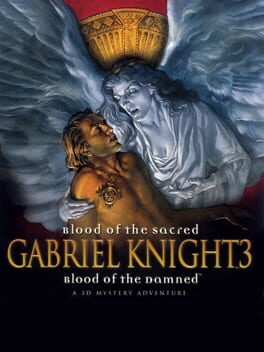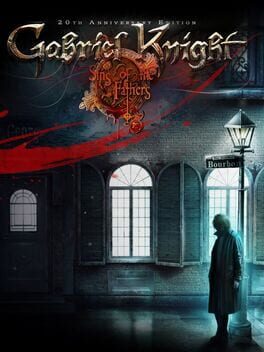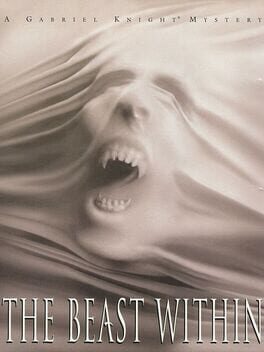

Gabriel Knight 3: Blood of the Sacred, Blood of the Damned
released on Oct 05, 1999
Play as both Gabriel Knight and Grace Nakimura as you learn more about what is hidden in the hills of France.
Also in series
Reviews View More
The least enjoyable in the series, but still a great game. This period, with the early transition into 3D polygon animation, was fucking rough dude. The first game had beautiful pixels, the second had cool FMV, this one just looked ugly in comparison.
Also, the puzzles were bullshit in this game, I remember using a guide frequently for this one.
Also, the puzzles were bullshit in this game, I remember using a guide frequently for this one.
I’ll be honest: When I first laid eyes on Gabriel Knight 3, I found it ugly. It reminded me of that phase where 'traditional' 2D point-and-click adventures jumped on the 3D bandwagon, which mostly meant that they had a less pretty art style and/or had to incorporate new controls to move the player character in three-dimensional space; which, seeing how the pointing-and-clicking mechanic had developed to be even more comfortable to use - compare the SCUMM commands to the context menus or change of cursor - seems like a step back. Also, I couldn’t get the game to run properly and it would frequently crash. I played for maybe five minutes, got discouraged, and dropped it.
Well, considering Gabriel Knight 1 & 2 are among my favourite video games ever, and replaying them made me crave more of that Jane Jensen Magic™, I gave GK3 a second try. I’m no PC expert, but I got it to run well and, to my surprise, I quickly immersed myself in the game world. It reminded me of simpler times, where the graphical power of a PS1 was enough to let me daydream and wonder about all these worlds I could enter. And reading this interview about the nearly disastrous development of the game that almost led to it being canceled made me appreciate the end product all the more.
And it actually plays well. The only time it stutters a bit is if you try to move the camera directly after saving/loading; it takes a few seconds to run smoothly again. The cursor is used in old point-and-click fashion: If it changes its colour slightly, you can left-click on the object to open a context menu to further interact with it. Right-clicking lets you access your inventory as well as the settings. The keyboard, in conjunction with the mouse, is used to move the camera, which isn’t tied to the player character. This takes some time getting used to, but it works and is probably the best way to make the genre work in 3D space. The context menu usually includes the option to put the camera at an optimal angle to view something, which is very helpful. What’s interesting to note is that this whole new perspective also shaped some of the puzzles and how specific scenes will play out in real time.
Similar to its predecessors, GK3 is divided into chapters. Unlike them, a chapter doesn’t last a whole day, but only a few hours. This makes the world feel more alive, because as the time progresses, NPCs will do different things at different locations. A chapter ends when specific conditions are met, e.g. a specific puzzle solved or clue unveiled. But along the way are often optional things to be done, which, while not necessary to complete the game, broaden your perspective on things. One example: At one point you will get a fingerprint kit. Throughout the game you will have several opportunities to get the fingerprints from your pool of suspects. You can miss some (or even all of them?), but getting them and finding out stuff by yourself is more rewarding. This 'optional side-quest' works understandably especially well with the constant movement of characters between chapters. Even smaller things like dialogue options or just investigating objects more thoroughly is optional stuff that yields you - apart from being rewarding in itself - extra points. It may be frustrating from a completionist standpoint to miss some of these things (there are also timed events), but it, too, makes the investigation and world feel more alive. You can also save anytime, as well as quicksave, so doing that before you enter a new area at a new time makes potential backtracking less tedious.
The story is again dealing with the supernatural, which is intertwined with real world history and beliefs. It starts in medias res with Gabriel following a pair of maybe (definitely) vampiric kidnappers in France and spins a complex tale where a conspiracy about a hidden treasure and the involvement of the Knights Templar only marks the beginning. The in-game computer (which is also used for a rather complex but fascinating series of puzzles) even has its own little Wikipedia-like database with dozens of entries relating to all the events mentioned in the game. The investigation and uncovering of all mysteries is very captivating.
If there is one thing to criticize about the story it's that its different threads don’t lead to quite a satisfying ending; I feel that the primary antagonist and his unfolding scheme in the end are a bit lacking. On the other hand, the game succeeds in giving a pretty WTF revelation at the end that feels rather daring. It also makes me sad that we’ll probably never get a fourth entry in the series, oh well… at least we get a free post-GK3 short story / comic (Sadly, the website shut down, but the story is still available in both formats via the Wayback Machine/Internet Archive // Spoilers for the whole series).
The characters and dialogue are interesting and witty as always, and I especially like how Gabriel and Grace grow individually, as well as how their relationship develops. Gabriel is once again voiced by Tim Curry, who manages to walk the fine line of Gabriel's characterization; honestly, many dialogue bits that he mumbles to himself would sound plain ridiculous if it weren’t for his coolness and attitude, he’s fantastic.
What else is fantastic? The soundtrack! It’s composed by David Henry and Robert Holmes. While Holmes had previously contributed to the series, Henry was new. I couldn’t find any decisive info how big each composer's contribution for the whole thing was, but from my understanding Henry was the main composer and took inspiration from Holmes' established themes for the series.
In the end all that is left to say for me is that I find it fascinating how the Gabriel Knight series turned out. Starting as a more traditional 2D pixel-y point-and-click game (from today’s perspective, its direction was a whole new thing for Sierra at the time), becoming an FMV adventure and lastly transforming into 3D: Every entry is a fresh, unique experience, while the essence of what makes the series great stays the same. After initially rejecting Gabriel Knight 3, I now wouldn’t have it any other way.
-----
- Again, I’m no expert, but how it worked for me on Windows 10 was: Right-click on the .exe file that launches the game --> go to properties, then compatibility --> make it run in compatibility mode for Windows 95, select the 640x480 screen resolution, deactivate full screen optimization, et voilà!
- FYI: When you overwrite a save, make sure to hit 'Save' again after agreeing to overwrite it :)
Well, considering Gabriel Knight 1 & 2 are among my favourite video games ever, and replaying them made me crave more of that Jane Jensen Magic™, I gave GK3 a second try. I’m no PC expert, but I got it to run well and, to my surprise, I quickly immersed myself in the game world. It reminded me of simpler times, where the graphical power of a PS1 was enough to let me daydream and wonder about all these worlds I could enter. And reading this interview about the nearly disastrous development of the game that almost led to it being canceled made me appreciate the end product all the more.
And it actually plays well. The only time it stutters a bit is if you try to move the camera directly after saving/loading; it takes a few seconds to run smoothly again. The cursor is used in old point-and-click fashion: If it changes its colour slightly, you can left-click on the object to open a context menu to further interact with it. Right-clicking lets you access your inventory as well as the settings. The keyboard, in conjunction with the mouse, is used to move the camera, which isn’t tied to the player character. This takes some time getting used to, but it works and is probably the best way to make the genre work in 3D space. The context menu usually includes the option to put the camera at an optimal angle to view something, which is very helpful. What’s interesting to note is that this whole new perspective also shaped some of the puzzles and how specific scenes will play out in real time.
Similar to its predecessors, GK3 is divided into chapters. Unlike them, a chapter doesn’t last a whole day, but only a few hours. This makes the world feel more alive, because as the time progresses, NPCs will do different things at different locations. A chapter ends when specific conditions are met, e.g. a specific puzzle solved or clue unveiled. But along the way are often optional things to be done, which, while not necessary to complete the game, broaden your perspective on things. One example: At one point you will get a fingerprint kit. Throughout the game you will have several opportunities to get the fingerprints from your pool of suspects. You can miss some (or even all of them?), but getting them and finding out stuff by yourself is more rewarding. This 'optional side-quest' works understandably especially well with the constant movement of characters between chapters. Even smaller things like dialogue options or just investigating objects more thoroughly is optional stuff that yields you - apart from being rewarding in itself - extra points. It may be frustrating from a completionist standpoint to miss some of these things (there are also timed events), but it, too, makes the investigation and world feel more alive. You can also save anytime, as well as quicksave, so doing that before you enter a new area at a new time makes potential backtracking less tedious.
The story is again dealing with the supernatural, which is intertwined with real world history and beliefs. It starts in medias res with Gabriel following a pair of maybe (definitely) vampiric kidnappers in France and spins a complex tale where a conspiracy about a hidden treasure and the involvement of the Knights Templar only marks the beginning. The in-game computer (which is also used for a rather complex but fascinating series of puzzles) even has its own little Wikipedia-like database with dozens of entries relating to all the events mentioned in the game. The investigation and uncovering of all mysteries is very captivating.
If there is one thing to criticize about the story it's that its different threads don’t lead to quite a satisfying ending; I feel that the primary antagonist and his unfolding scheme in the end are a bit lacking. On the other hand, the game succeeds in giving a pretty WTF revelation at the end that feels rather daring. It also makes me sad that we’ll probably never get a fourth entry in the series, oh well… at least we get a free post-GK3 short story / comic (Sadly, the website shut down, but the story is still available in both formats via the Wayback Machine/Internet Archive // Spoilers for the whole series).
The characters and dialogue are interesting and witty as always, and I especially like how Gabriel and Grace grow individually, as well as how their relationship develops. Gabriel is once again voiced by Tim Curry, who manages to walk the fine line of Gabriel's characterization; honestly, many dialogue bits that he mumbles to himself would sound plain ridiculous if it weren’t for his coolness and attitude, he’s fantastic.
What else is fantastic? The soundtrack! It’s composed by David Henry and Robert Holmes. While Holmes had previously contributed to the series, Henry was new. I couldn’t find any decisive info how big each composer's contribution for the whole thing was, but from my understanding Henry was the main composer and took inspiration from Holmes' established themes for the series.
In the end all that is left to say for me is that I find it fascinating how the Gabriel Knight series turned out. Starting as a more traditional 2D pixel-y point-and-click game (from today’s perspective, its direction was a whole new thing for Sierra at the time), becoming an FMV adventure and lastly transforming into 3D: Every entry is a fresh, unique experience, while the essence of what makes the series great stays the same. After initially rejecting Gabriel Knight 3, I now wouldn’t have it any other way.
-----
- Again, I’m no expert, but how it worked for me on Windows 10 was: Right-click on the .exe file that launches the game --> go to properties, then compatibility --> make it run in compatibility mode for Windows 95, select the 640x480 screen resolution, deactivate full screen optimization, et voilà!
- FYI: When you overwrite a save, make sure to hit 'Save' again after agreeing to overwrite it :)



